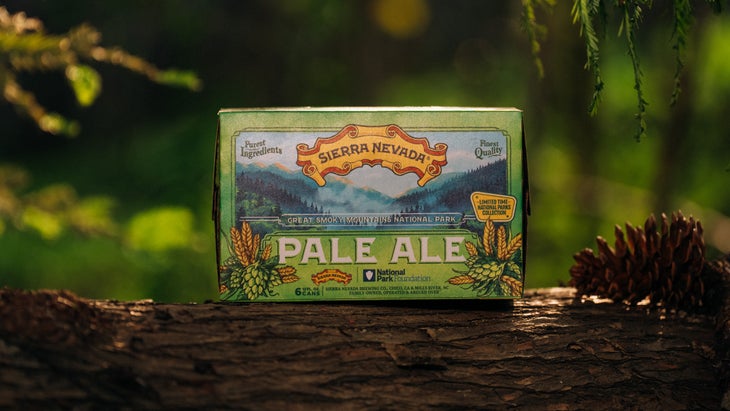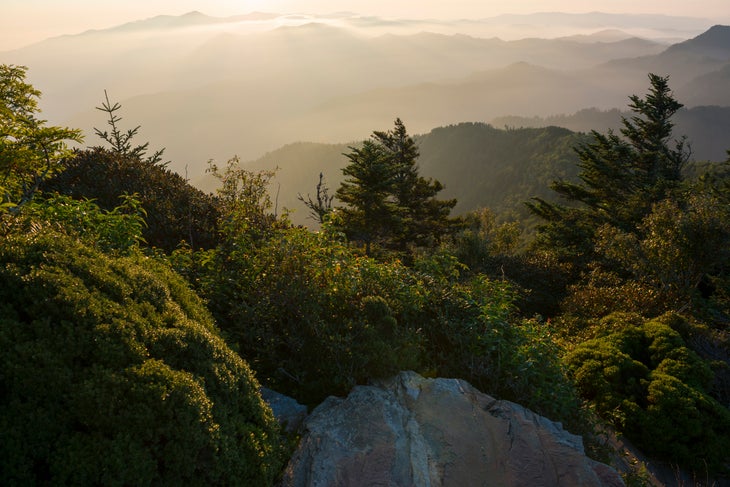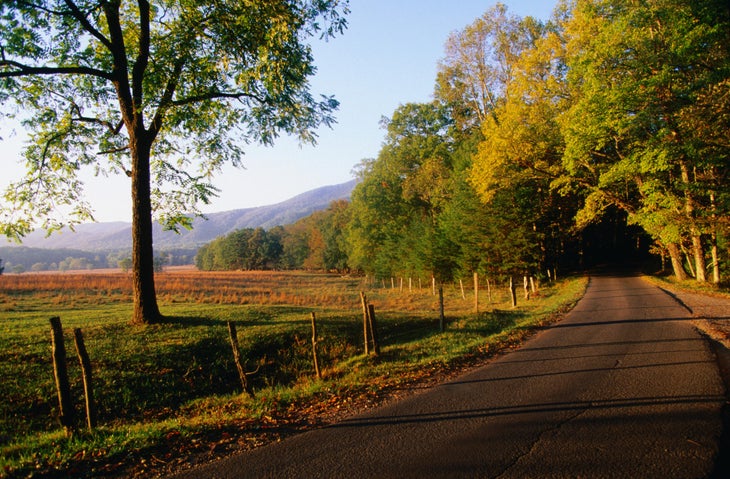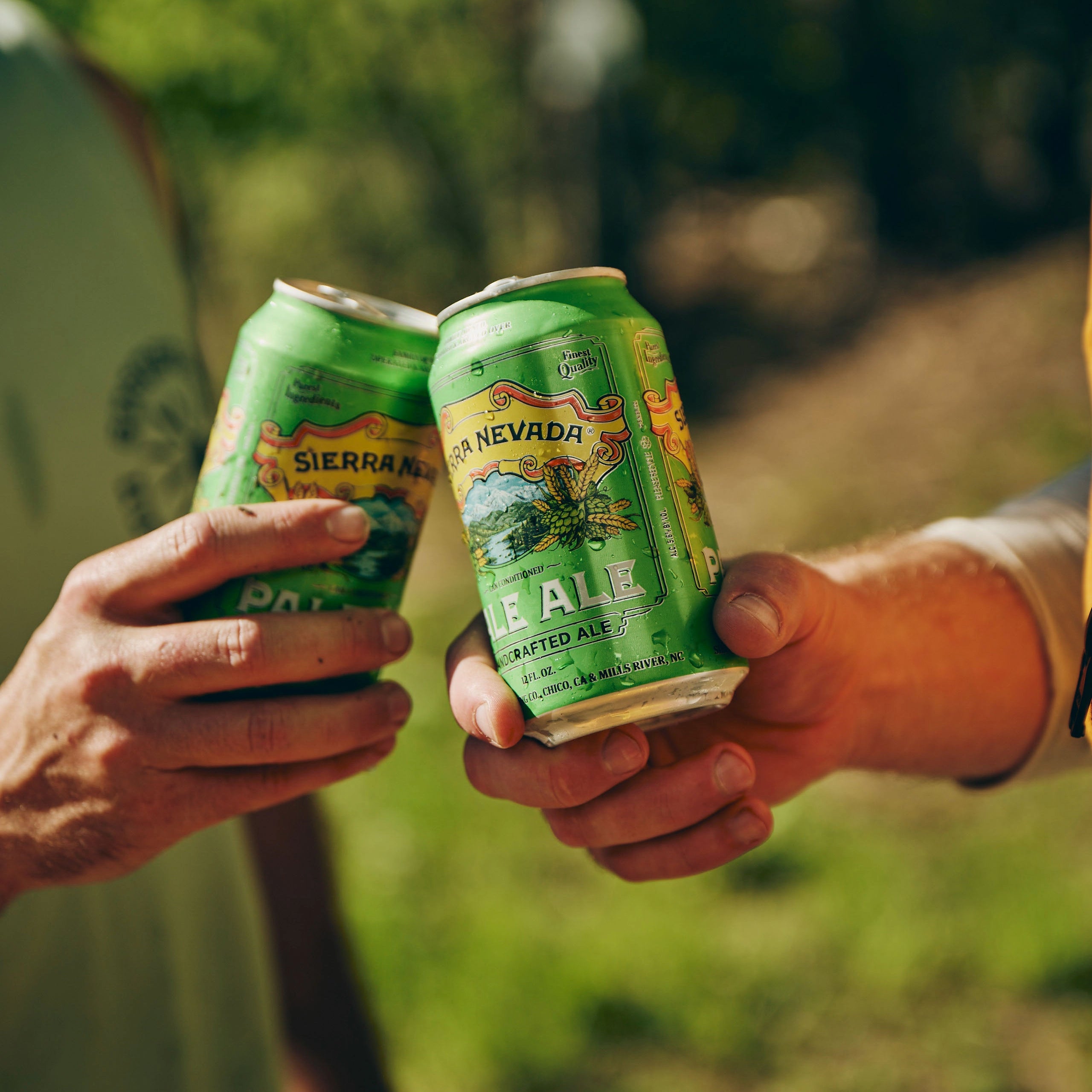Some people hear that Great Smoky Mountains is America’s most-visited national park and think it’s a reason to stay away. The opposite is true. There’s a reason it’s so popular: This spectacular wilderness is packed with diverse ecosystems, plants, and animals—and it’s easy to avoid the crowds if you know where to look.
What will you find? In the park’s higher elevations, peregrine falcons soar over 6,000-plus-foot Appalachian peaks, and blooming rhododendrons decorate mountaintop balds. Waterfalls careen from rocky points, feeding streams full of salamanders and native brook trout. The lowland hardwood forests provide wild habitat for black bears, saw-whet owls, and elk. The Smokies are a beloved refuge for hundreds of species—hikers included.
How do we ensure it stays that way for generations to come? Support and protect the park. That’s why is celebrating Great Smoky Mountains this spring. The brewery is featuring a of its flagship Pale Ale dedicated to four national parks, Great Smoky Mountains included. (The other three are Big Bend, Yellowstone, and Yosemite.) The beer hasn’t changed, but the artful limited-edition packaging shines a spotlight on these iconic parks.

Sierra Nevada Brewing Co. is backing that up with a donation to the to support wildlife and habitat conservation. “Our national parks are a jewel that we need to preserve,” Sierra Nevada founder Ken Grossman says. “Connection to nature is really critical. I think it’s our legacy to preserve those places forever.”
Amie Engerbretson, professional skier and Sierra Nevada Brewing Co. ambassador, agrees. “The national parks are where you see the very best that Mother Nature has to offer,” she says. “And they’re so accessible, it makes it possible for all people to see some of the coolest places in the world.”

With so many options on the table and 848 miles of trails, it can be hard to decide exactly where to spend your time in the park. Plan the perfect trip with this guide to the Smokies’ can’t-miss spots to hike, camp, explore, and “cheers!” a day well spent.
Best Waterfall Hike
Deep Creek Waterfalls Loop
This quiet day hike in the lush jams three cascades into just 2.4 miles: dramatic 90-foot Juney Whank Falls, flowy 25-foot Indian Creek Falls, and lacy 60-foot Tom Branch Falls. Start on the steep Juney Whank Falls Trail, then connect to Deep Creek Horse Trail, Deep Creek Trail, and Indian Creek Trail to reach waterfall number two. Loop back on Deep Creek Trail to reach Tom Branch Falls and continue on to the trailhead. Hot-weather tip: Carry a tube to the first two falls (plenty of rentals are available nearby), then hop into Deep Creek and float past Tom Branch Falls en route to the takeout near the park boundary.
Pale Ale moment: Back at the trailhead, head to the picnic area and dip your toes in Deep Creek while you savor an ice-cold Sierra Nevada.
Best Overlook
Charlies Bunion
Sample the famed Appalachian Trail to reach this big-view overlook. Starting from the nearly mile-high Newfound Gap, follow the AT east through the spruce-fir forest, enjoying plenty of mountain views along the way. There’s no mistaking at mile four: Grab a perch on the rocky knob and revel in the panorama of peaks and valleys radiating beneath your boots. If you’re not in the mood to share this justifiably popular overlook, hit the trail early or in late afternoon, or target the off-season.
Pale Ale moment: Head back down the mountain to Collins Creek Picnic Area, a shady refuge along a burbling creek perfect for sipping.
Best Peak Hike
Mount LeConte
Five different trails lead to LeConte’s 6,593-foot summit, the park’s third-highest peak. Our money is on the ten-mile round-trip Alum Cave Trail, with highlights including a hike-through rock arch, the cliffy overhang of Alum Cave Bluffs, and narrow ledges to traverse (equipped with metal cables to grab for stability). Up top, spin-around views of the park await.

Pale Ale moment: Say “Cheers!” from the rocking chair on your cabin’s porch at the rustic , the only hotel in the park (typically open March to November).
Best Overnight
Gregory Bald
The Smokies’ “balds,” or open, grassy mountainside meadows, are botanical wonderlands when the flame azaleas bloom—and gorgeous viewpoints when they’re not. Rangers keep in its historically open state with string trimmers and a lawnmower, one of only two such maintained spots in the park. Researchers think the wide-open balds were created by grazing animals, first by mastodons and woolly mammoths, and later by deer and elk. Several trails will get you there, but the 6.8-mile one-way Wolf Ridge Trail from the Twentymile area is less traveled than the rest.
Pale Ale moment: Raise a toast from backcountry campsite 13, which lets you bunk right on the bald.
Best Bike Ride
Cades Cove Loop Road
Truth #1: Cades Cove is an idyllic valley filled with wildlife, historic buildings and cemeteries, and wildflowers. Truth #2: It can be a total mob scene, with backed-up traffic. Truth #3: You can beat the crowds—and enjoy a world-class bike ride on the 11-mile Cades Cove Loop Road—by visiting on in summer. Hop on your favorite two-wheeler (Class 1 and 2 e-bikes are OK; bike rentals available on site) and cruise the rolling route, allowing time to stop and explore spots like Cable Mill and John Oliver Cabin.

Pale Ale moment: Go for a creekside table at either Abrahms or Green Branch creek, both of which border the area, in Cades Cove Picnic Area at the loop’s start.
Best Campground
Balsam Mountain Campground
Campsites in the Smokies tend to be verdant, peaceful, and, in summer, wicked hot and humid. Not so up at 5,310 feet at , which enjoys a much cooler climate. The flat Balsam Mountain Nature Trail, a 1.2-mile out-and-back, leaves right from the campground and makes for a nice leg stretcher.
Pale Ale moment: Snag one of this quiet campground’s 43 sites, gather ’round the campfire, and toast your good sense to be here.
Note: It’s always smart to check the for current conditions before your trip. And when planning a Pale Ale moment of your own, check the park’s .
Sierra Nevada Brewing Co., founded by Ken Grossman in 1980, is a pioneer in craft brewing. With breweries in California and North Carolina, it’s known for quality ingredients, innovation, and sustainability. Popular beers include Pale Ale, Hazy Little Thing, and Torpedo. Learn more at .


